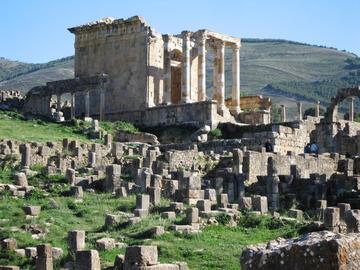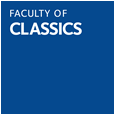Oxford Ancient History Faculty Seminar Hilary Term 2023

Oxford Ancient History Faculty Seminar Hilary Term 2023
Tuesdays 4pm at the Ioannou Centre, 66 St Giles
Ancient North Africa: Histories, Cities, and Landscapes
Week 1 (17 January) Andrew Dufton (Dickinson College)
The neighbourhoods of Roman North Africa
The neighbourhood presents a useful intermediate scale of analysis to trace the oft-contradictory urban dynamics of the Roman world. Neighbourhoods are larger than the individual building or monument and yet smaller than the city as a whole, a space where tensions unfurl between top-down ideals and local concerns. This paper explores the neighbourhoods of Roman North Africa—how we might identify urban quarters in the archaeological and architectural record, and what neighbourhood life can tell us about the larger forces shaping urban change.
Week 2 (24 January) Olivier Hekster (Radboud University)
The production of memory lane in North Africa
This lecture will explore how material and intellectual landmarks ‘created’ Roman North Africa. Buildings, statuary, coins and inscriptions that people encountered in the landscape of Roman North Africa could be reflections of Roman officialdom or of local reactions to Roman involvement in the region – and sometimes even both at the same time. How did such monuments and other landmarks help to create (and occasionally hinder) a quintessentially ‘Roman North-African’ lived space in several centuries of Roman rule?
Week 3 (31 January) Corisande Fenwick (UCL)
Reconquering Africa: Roman imperialism and the city in the age of Justinian
Reconquest is a common, yet understudied, mode of imperialism. This paper examines Justinian’s conquest of North Africa in the sixth century and the complexities of integrating Africa and its peoples into the Roman empire again after nearly a hundred years of Vandal rule. It focuses particularly on the transformation of North African cityscapes through an analysis of military, economic and religious building investment in the aftermath of the conquest.
Week 4 (7 February) Muna Haroun Abdelhamed (joint with BILNAS – The British Institute for Libyan and Northern African Studies)
The story of Cyrenaican horses in the Greek and Roman periods and its reality
Our knowledge about breeding horses in Cyrenaica during Greek and Roman periods is mainly derived from ancient literary references. This talk presents the main stories about this noble animal and Cyrenaican charioteers’ performance in overseas athletic games. It also addresses whether these assertions represent a reality or, simply a convention.
Week 5 (14 February) Sam Agbamu (University of Reading)
Landscapes of Enmity: Rome, Africa, and the Places in Between
In a 1943 essay on Rome and Africa, the Italian archaeologist Pietro Romanelli suggested that ‘Rome and Africa cannot ignore each other, they cannot but meet in the sea in which one and the other bathe […] a relationship has, from birth, been inevitable’. I will examine this suggestion by considering how Latin literature’s conceptualisations of the geography of Italy, Africa, and the places in-between have contributed to explanations of Rome’s relationship with the continent to the south of the Mediterranean, from the Punic Wars, up until the colonisation of African territory by Mussolini’s new Roman Empire.
Week 6 (21 February) Matthew McCarty (UBC)
Stelae and the Semiotics of Sacrifice: Worship Traditions in Roman Africa
Since their discovery in 1930, a group of 2nd-3rd century CE inscribed votive stelae from N’Gaous (Algeria), each of which seems to describe an act called morchomor, has played an outsize role shaping foundational understandings within three distinct fields: biblical, Punic, and Roman-African studies. Yet such interpretations of the stelae, which hold them up as paradigmatic of different historical phenomena, also reveal the ways that culture-historical metanarratives and epigraphic positivism have distorted understandings of ancient North Africa. This paper challenges the assumptions underlying these prevalent models by re-situating the N’Gaous stelae within the context of lived ancient religion and through applying a semiotic framework. I argue that the N’Gaous stelae do not describe a substitution sacrifice; they work to enact that substitution through their textual and visual rhetoric. Acknowledging that the stelae work in this way immediately sets them apart from the stelae – and rites – at other stele-sanctuaries of Roman imperial-period Africa, as even quick comparison will show. Both the aim of the rites – to perform a substitution – and the technical means used to achieve that end – inscribed rhetoric – make the N’Gaous stelae not paradigmatic, but nearly unique. Although the N’Gaous stelae cannot carry the evidentiary burden with which they have been freighted by modern scholarship, understanding them as a kind of ritual bricolage allows us better to understand the processes of religious innovation and invention that characterize the imperial period in North Africa.
Week 7 (28 February) Stefan Ardeleanu (University of Hamburg)
Numidia between micro-regionalism and global trends. A new archaeological approach to North African urbanism and settlement hierarchy
This paper examines the latest developments coming out of recently intensified archaeological fieldwork on pre- and Early Roman settlement in Numidia. It will operate from a methodological premise that both global trends and local/micro-regional patterns were at work simultaneously in this crucial zone of North Africa. The paper will put special emphasis on the connectivity of Numidia’s towns with the Mediterranean world both before and after the Roman conquest. It will also expand on the longue durée of micro-regional characteristics in material culture and on the development of settlement hierarchies during the highly transformative period of ca. 200 BC to 100 AD.
Week 8 (7 March) Sailakshmi Ramgopal (Columbia University)
The Business of Being Roman: Power, Citizenship, and Provincial Administration in North Africa
The expansion of Rome's power in the second century BCE presented both the Republic and ordinary Roman citizens with a problem: the growing presence of Romans beyond Italy. This paper attends to a single dimension of this change by exploring the formation of voluntary associations by Romans who lived as minorities in provincial cities and the roles that such groups played in relationships between Rome and the cities of North Africa.
Organisers:
Jo Quinn (josephine.quinn@classics.ox.ac.uk), Niccolò Mugnai, Monica Hellström, Tim Smith



